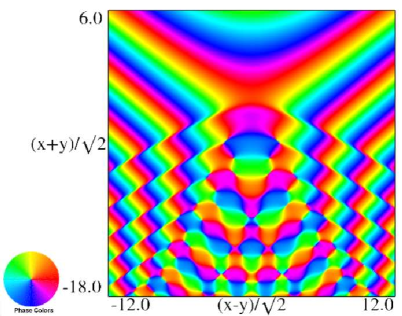hyperbolic cosecant function
(0.006 seconds)
21—30 of 32 matching pages
21: 19.11 Addition Theorems
22: 19.6 Special Cases
§19.6(v)
…23: 4.15 Graphics
§4.15(i) Real Arguments
… ►§4.15(iii) Complex Arguments: Surfaces
►In the graphics shown in this subsection height corresponds to the absolute value of the function and color to the phase. … ►24: 1.14 Integral Transforms
Periodic Functions
… ►The Mellin transform of a real- or complex-valued function is defined by … ►The Stieltjes transform of a real-valued function is defined by …25: 19.8 Quadratic Transformations
26: 19.16 Definitions
§19.16(ii)
… ►The -function is often used to make a unified statement of a property of several elliptic integrals. …where is the beta function (§5.12) and … ►For generalizations and further information, especially representation of the -function as a Dirichlet average, see Carlson (1977b). …27: 11.5 Integral Representations
§11.5(i) Integrals Along the Real Line
… ►§11.5(ii) Contour Integrals
… ►Mellin–Barnes Integrals
►§11.5(iii) Compendia
…28: 10.22 Integrals
§10.22(i) Indefinite Integrals
… ►Products
… ►Orthogonality
… ►Orthogonality
… ►The Hankel transform (or Bessel transform) of a function is defined as …29: 22.11 Fourier and Hyperbolic Series
§22.11 Fourier and Hyperbolic Series
… ►30: Errata
Originally, the factor on the right-hand side was written as , which was taken directly from Watson (1944, p. 412, (13.46.5)), who uses a different normalization for the associated Legendre function of the second kind . Watson’s equals in the DLMF.
Reported by Arun Ravishankar on 2018-10-22
Scales were corrected in all figures. The interval was replaced by and replaced by . All plots and interactive visualizations were regenerated to improve image quality.
 |
 |
| (a) Density plot. | (b) 3D plot. |
Figure 36.3.9: Modulus of hyperbolic umbilic canonical integral function .
 |
 |
| (a) Density plot. | (b) 3D plot. |
Figure 36.3.10: Modulus of hyperbolic umbilic canonical integral function .
 |
 |
| (a) Density plot. | (b) 3D plot. |
Figure 36.3.11: Modulus of hyperbolic umbilic canonical integral function .
 |
 |
| (a) Density plot. | (b) 3D plot. |
Figure 36.3.12: Modulus of hyperbolic umbilic canonical integral function .
Reported 2016-09-12 by Dan Piponi.
The scaling error reported on 2016-09-12 by Dan Piponi also applied to contour and density plots for the phase of the hyperbolic umbilic canonical integrals. Scales were corrected in all figures. The interval was replaced by and replaced by . All plots and interactive visualizations were regenerated to improve image quality.
 |
 |
| (a) Contour plot. | (b) Density plot. |
Figure 36.3.18: Phase of hyperbolic umbilic canonical integral .
 |
 |
| (a) Contour plot. | (b) Density plot. |
Figure 36.3.19: Phase of hyperbolic umbilic canonical integral .
 |
 |
| (a) Contour plot. | (b) Density plot. |
Figure 36.3.20: Phase of hyperbolic umbilic canonical integral .
 |
 |
| (a) Contour plot. | (b) Density plot. |
Figure 36.3.21: Phase of hyperbolic umbilic canonical integral .
Reported 2016-09-28.
The first paragraph has been rewritten to correct reported errors. The new version is reproduced here.
Let and be real constants and
The roots of
are:
-
(a)
, , and , with , when .
-
(b)
, , and , with , when , , and .
-
(c)
, , and , with , when .
Note that in Case (a) all the roots are real, whereas in Cases (b) and (c) there is one real root and a conjugate pair of complex roots. See also §1.11(iii).
Reported 2014-10-31 by Masataka Urago.
Originally the limiting form for in the last line of this table was incorrect (, instead of ).
Reported 2010-11-23.
